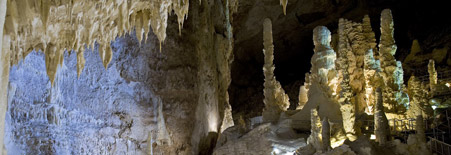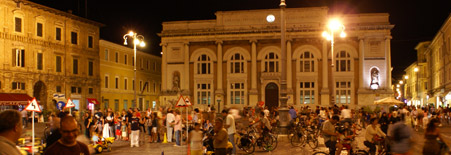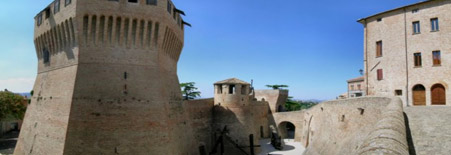With a view stretching from the hills to the sea, you can experience the atmosphere of a relaxing soak in the green landscapes, combined with a beach holiday or cultural proximity to the city of Fano, Pesaro, Urbino, Gradara, Mondavio and many other historical towns/rural.
———————-
 FANO – is an Italian town of 61,200 inhabitants in the province of Pesaro and Urbino in the Marche. The city, famous for its carnival, the oldest in Italy, appears to be the third largest city by population in the region of Marche, Ancona and Pesaro after is an Italian town of 61,200 inhabitants in the province of Pesaro and Urbino in the Marche. Fanum Fortunae in Roman times, today very popular seaside resort and fishing port of the most important of the Adriatic, Fano is his territory retains, in fact, a cultural, historical and environmental-notch.
FANO – is an Italian town of 61,200 inhabitants in the province of Pesaro and Urbino in the Marche. The city, famous for its carnival, the oldest in Italy, appears to be the third largest city by population in the region of Marche, Ancona and Pesaro after is an Italian town of 61,200 inhabitants in the province of Pesaro and Urbino in the Marche. Fanum Fortunae in Roman times, today very popular seaside resort and fishing port of the most important of the Adriatic, Fano is his territory retains, in fact, a cultural, historical and environmental-notch.
PESARO – City wet from the Adriatic, with its heritage of the past and present, has had and still grow and gain the attention of guests and art lovers of beaches. Must visit the Teatro Grande century dedicated to Gioachino Rossini, who like every year in August hosts the Rossini Opera Festival, do not miss his native home in the historic center. Now part of the municipal Pesaro even the ancient castles of Novilara (m.215) and Candelara (m. 204), with lovely view.
MONDAVIO – The fortress of Mondavio is one of the most important and interesting testimonies of the project activity in the military by Francesco di Giorgio Martini in the Marches. It was built by commission of Giovanni della Rovere, along with other fortresses of the Duchy (Cagli, Cantiano, Fossombrone, Gable, Sassocorvaro, Pergola, Mondolfo), and probably dates back to the later phase of the Sienese architect, probably decade 1482-1492. The building remained unfinished for the return of the architect Francesco di Giorgio Martini in his native Siena and the subsequent concomitant death of both the buyer is the architect Giovanni della Rovere (1501). In 1631, the death of the last Duke of Urbino (Francesco Maria II della Rovere), the duchy again part of the Papal States and the fortress of Mondavio not having defensive purposes is transformed into papal prison. Such use continues even after the unification of Italy until the forties of the twentieth century
 URBINO – The ancient capital of the Duchy of Montefeltro (35 km from Pesaro) stands atop two hills and along their slopes with roofs of houses and churches sloping down towards Porta Lavagine north-east and Porta Valbona to the south-west . It is one of the major art towns in the world, because of its history and the many monuments and works of art in it. Has ancient origins, but it has only documentation from the third century BC, when Urvinum Mataurense was declared a Roman municipality (remains of walls and the theater). The strategic location favored its involvement in the struggles that characterized the feudal period, when it sided with the Ghibellines and Antonio da Montefeltro, putting down a revolt in Rome against the Emperor Frederick Barbarossa, conquered on the field the title of count and the charge of imperial Vicar of Urbino (1155)
URBINO – The ancient capital of the Duchy of Montefeltro (35 km from Pesaro) stands atop two hills and along their slopes with roofs of houses and churches sloping down towards Porta Lavagine north-east and Porta Valbona to the south-west . It is one of the major art towns in the world, because of its history and the many monuments and works of art in it. Has ancient origins, but it has only documentation from the third century BC, when Urvinum Mataurense was declared a Roman municipality (remains of walls and the theater). The strategic location favored its involvement in the struggles that characterized the feudal period, when it sided with the Ghibellines and Antonio da Montefeltro, putting down a revolt in Rome against the Emperor Frederick Barbarossa, conquered on the field the title of count and the charge of imperial Vicar of Urbino (1155)
 GROTTE DI CAVES – are of underground karst caves that are located within the natural park of the Red Gorge and Frasassi in Genga in the province of Ancona. They are one of the most beautiful sights in the whole territory of central Italy. Notes to the stalactites and stalagmites, limestone concentrations secular, from different forms. They are characterized by a set of underground paths of length of about 30km, but only a 1.5 km are open to the public in three locations (Tourist, Blue and Red). The temperature inside never exceeds 14 ° C..
GROTTE DI CAVES – are of underground karst caves that are located within the natural park of the Red Gorge and Frasassi in Genga in the province of Ancona. They are one of the most beautiful sights in the whole territory of central Italy. Notes to the stalactites and stalagmites, limestone concentrations secular, from different forms. They are characterized by a set of underground paths of length of about 30km, but only a 1.5 km are open to the public in three locations (Tourist, Blue and Red). The temperature inside never exceeds 14 ° C..
 GRADARA – The Rock of Gradara and its fortified village are one of the best preserved medieval structures of Italy and the two walls that protect the fortress, the outermost of which extends for almost 800 meters, making it also one of the most impressive . The castle stands on a hill 142 meters above sea level and the keep, the main tower, rises to 30 meters, dominating the entire valley. The fortunate position of Gradara makes, since ancient times, a crossroads of traffic and people: during the Middle Ages the fortress was one of the main theaters of clashes between the militias of the Papal States and the turbulent Houses Marche and Romagna, while our days, thanks to the proximity to the sea, is located just inland from one of the main tourist destinations of Italy, the Marche-Romagna Riviera.
GRADARA – The Rock of Gradara and its fortified village are one of the best preserved medieval structures of Italy and the two walls that protect the fortress, the outermost of which extends for almost 800 meters, making it also one of the most impressive . The castle stands on a hill 142 meters above sea level and the keep, the main tower, rises to 30 meters, dominating the entire valley. The fortunate position of Gradara makes, since ancient times, a crossroads of traffic and people: during the Middle Ages the fortress was one of the main theaters of clashes between the militias of the Papal States and the turbulent Houses Marche and Romagna, while our days, thanks to the proximity to the sea, is located just inland from one of the main tourist destinations of Italy, the Marche-Romagna Riviera.
THE LEGGEND
Amor, ch’al cor gentile ratto s’apprende,
prese costui della bella persona
che mi fu tolta; e ‘l modo ancor m’offende.
Amor, ch’ha nullo amato amar perdona,
mi prese del costui piacer sì forte,
che, come vedi, ancor non m’abbandona.
The verses of Dante, touching and so full of passion, describe superbly enthusiasm for love and the tragedy of the two young lovers viciously killed, that tradition has had as theater Gradara Castle. Francesca da Polenta, daughter of Guido Minor, lord of Ravenna, married in 1275 the son of Malatesta da Verucchio, Lord of Gradara, John said “The lame” or Giangiotto, in accordance with the ruthless game of matrimonial alliances. Giangiotto was at that time mayor of Pesaro and a law of the time forbade the magistrate to carry in the city managed his family.
Francesca, therefore, most likely resided in Gradara, both for its proximity to Pesaro, a half hour of riding, and because it was one of the most beautiful fortresses Malatesta and safe. Francesca, “woman of singular grace, and of infinite mysterious beauty”, was often alone for prolonged absences of her husband and had certainly appreciate the visits of the beautiful Paul, brother of Giangiotto. One day, however, the two young men came upon a reading that will mark their destiny, the story of Lancelot and Guinevere: transported by the passion of the lovers literary, Paolo and Francesca were unable to suppress their desire, and Paul finally … mouth kissed me all tremante.Galeotto was the book and he who wrote that day we read no more avante.I two lovers were surprised by Giangiotto them both pierced with a sword. Dante will place Paolo and Francesca in the group of the lustful, condemning them to eternal damnation but also eternal commemoration, elevating them to symbols of pure and unconditional.
 EN
EN  IT
IT 


